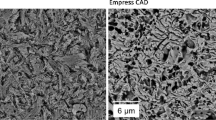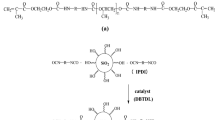Abstract
This paper focused on the influence of ingredients of silica suspensions and laser exposure on curing behavior of the highly concentrated aqueous silica suspensions. As a basic building unit, single cured lines were regarded as research objects to characterize the curing behavior of aqueous ceramic suspensions. The cured width and depth were characteristic parameters of single cured lines and measured with a digital optical microscope. The relationships between two characteristic parameters and ingredients of highly concentrated aqueous ceramic suspensions and laser exposure were investigated. The cured depth and width of single cured lines increased with the ceramic mean diameter and monomer concentrations. The cured width of single cured lines decreased with the solid content, but the cured depth increased with the solid content for silica suspensions. The cured depth and width of the single cured line all decreased with the laser scanning speed. The experimental results show that the ingredients of ceramic suspensions and laser exposure all have great influence on curing behavior of the highly concentrated silica suspensions, which indicates that the formula is an intrinsic factor on the curing behavior of ceramic suspensions and laser exposure is an exterior factor.
Similar content being viewed by others
References
Blackburn S (2005) New processes or old: complex shape processing of advanced ceramics. Advances in Applied Ceramics 104(3):97–102. doi:10.1179/174367605X16644
Giannatsis J, Dedoussis V (2009) Additive fabrication technologies applied to medicine and health care: a review. Int J Adv Manuf Technol 40:116–127. doi:10.1007/s00170-007-1308-1
Lee CW, Chua CK, Cheah CM, Tan LH, Feng C (2004) Rapid investment casting: direct and indirect approaches via fused deposition modelling. Int J Adv Manuf Technol 23:93–101. doi:10.1007/s00170-003-1694-y
Cheah CM, Chua CK, Lee CW, Feng C, Totong K (2005) Rapid prototyping and tooling techniques: a review of applications for rapid investment casting. Int J Adv Manuf Technol 25:308–320. doi:10.1007/s00170-003-1840-6
Bertrand P, Bayle F, Combe C, Smurov I (2007) Ceramic components manufacturing by selective laser sintering. Appl Surf Sci 254(4):989–992. doi:10.1016/j.apsusc.2007.08.085
Grau Jason E (1998) Fabrication of engineered ceramic components by the slurry-based three dimensional printing process. Ph.D. thesis, Massachusetts Institute of Technology
Allahverdi M, Danforth SC, Jafari M, Safari A (2001) Processing of advanced electroceramic components by fused deposition technique. J Eur Ceram Soc 21(10):1485–1490. doi:10.1016/S0955-2219(01)00047-4
Tay BY, Evans JRG, Edirisinghe MJ (2003) Solid freeform fabrication of ceramics. Int Mater Rev 48(6):341–370. doi:10.1179/095066003225010263
Tian XY, Günster J, Melcher J, Li DC, Heinrich JG (2009) Process parameters analysis of direct laser sintering and post treatment of porcelain components using Taguchi’s method. J Eur Ceram Soc 29(10):1903–1915. doi:10.1016/j.jeurceramsoc.2008.12.002
Tang HH, Liu FH (2005) Ceramic laser gelling. J Eur Ceram Soc 25:627–632. doi:10.1016/j.jeurceramsoc.2004.04.001
Tian XY, Li DC (2010) Rapid manufacture of net-shape SiC components. Int J Adv Manuf Technol 46:579–587. doi:10.1007/s00170-009-2109-5
Li X, Li DC, Lu BH, Wang CT (2008) Fabrication of bioceramic scaffolds with pre-designed internal architecture by gel casting and indirect stereolithography techniques. J Porous Mater 15:667–671. doi:10.1007/s10934-007-9148-9
Griffith ML (1995) Stereolithography of ceramics. Ph.D. thesis, The University of Michigan
Griffith ML, Halloran JW (1996) Freeform fabrication of ceramics via stereolithography. J Am Ceram Soc 79(10):2601–2608. doi:10.1111/j.1151-2916.1996.tb09022.x
Liao HM (1997) Stereolithography using compositions containing ceramic powders. Ph.D. thesis, The University of Toronto
Hinczewski C, Corbel S, Chartier T (1998) Ceramic suspensions suitable for stereolithography. J Eur Ceram Soc 18(6):583–590. doi:10.1016/S0955-2219(97)00186-6
Brakora KF (2007) Design of 3D monolithic millimeter-wave components using ceramic stereolithography. Ph.D. thesis, The University of Michigan
Chu MG (1999) Solid freeform fabrication of biomaterials. Ph.D. thesis, The University of Michigan
Griffith ML, Halloran JW (1997) Scattering of ultraviolet radiation in turbid suspensions. J Appl Phys 81(6):2538–2546. doi:10.1063/1.364311
Garg R (1999) Stereolithographic processing of ceramics: photon diffusion in colloidal dispersion. Ph.D. thesis, The University of Princeton
Brady GA, Halloran JW (1997) Stereolithography of ceramic suspensions. Rapid Prototyping J 3(2):61–65. doi:10.1108/13552549710176680
Brady GA, Chu MG, Halloran JW (1996) Curing behavior of ceramic resin for stereolithography. 7th Solid Freeform Fabrication Symposium. University of Texas, Austin, pp 403–410
Jacobs PF (1992) Rapid prototyping and manufacturing: fundamentals of stereolithography. Society of Manufacturing Engineers, Dearborn
Chartier T, Caput C, Doreau F, Loiseau M (2002) Stereolithography of structural complex ceramic parts. J Mater Sci 37:3141–3147. doi:10.1023/A:1016102210277
Zhou WZ, Li DC, Wang H (2010) A novel aqueous ceramic suspensions for ceramic stereolithography. Rapid Prototyping J 16(1):29–35. doi:10.1108/13552541011011686
van de Hulst HC (1981) Light scattering by small particles. Dover, New York
Fraden S, Maret G (1990) Multiple light scattering from concentrated, interacting suspensions. Phys Rev Lett 65(4):512–515. doi:10.1103/PhysRevLett.65.512
Jones AR (1999) Light scattering for particle characterization. Progr Energy Combust Sci 25:1–53. doi:10.1016/S0360-1285(98)00017-3
Wriedt T (2009) Light scattering theories and computer codes. J Quant Spectrosc Radiat Transfer 110:833–843. doi:10.1016/j.jqsrt.2009.02.023
Narrow TL, Yoda M, Abdel-Khalik SL (2000) A simple model for the refractive index of sodium iodide aqueous solutions. Exp Fluids 28(3):282–283. doi:10.1007/s003480050389
Author information
Authors and Affiliations
Corresponding author
Rights and permissions
About this article
Cite this article
Zhou, W., Li, D. & Chen, Z. The influence of ingredients of silica suspensions and laser exposure on UV curing behavior of aqueous ceramic suspensions in stereolithography. Int J Adv Manuf Technol 52, 575–582 (2011). https://doi.org/10.1007/s00170-010-2746-8
Received:
Accepted:
Published:
Issue Date:
DOI: https://doi.org/10.1007/s00170-010-2746-8




